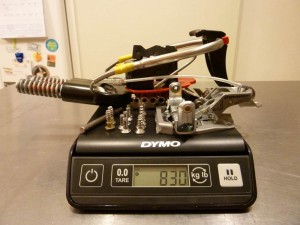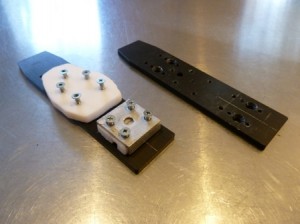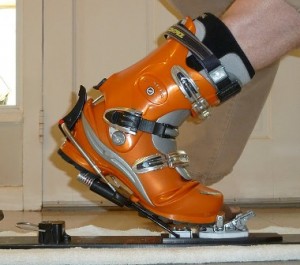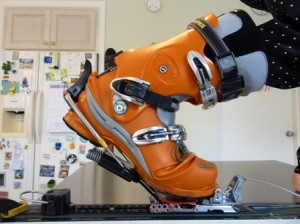(Editor’s Note: This is a telemark tinkerer’s system which resembles the commercially available Telemark Tech System® but only in terms of using a Tech Toe. Just about everything else is modified within the limits of a zealous but amateur home workshop. Ben did an outstanding job of creating his own version of a telemark binding using tech toes but some of the conclusions or references to TTS should be understood as creative variations but are not representative of the Telemark Tech System® sold by Olympus Mountain Gear.)
Like many telemarkers I was skeptical of the Telemark Tech System (TTS®) when it was unveiled at the 2011 Outdoor Retailer Winter Show. Being familiar with Dynafit bindings, I knew that the tech toe piece couldn’t be as robust as a standard telemark binding. By removing the heel it was essentially emasculated, becoming a flimsy toe attachment with no controls. Little did I know how two little pins could be so much more. Once the gears were rolling it was only a matter of time before I started to tinker with my own version.
I mounted my first set of tech-toes on Dynafit-telemark shift plates. I used the extra telemark mounting holes behind the tech toe mount to locate the hold downs for the heel assembly. I made the spring assembly hold down (fulcrum) from a polyurethane shim (cutting board) reinforced with aluminum channel and I used a steel pin as the pivot point. I added a riser (more cutting board) to the Dynafit toe to improve clearance between the boot sole and the hold down, and to equalize rocker induced heel rise.
Round 1
My first version of a home-brewed TTS used the expansion cable springs from Voile’s three pin cable binding. Despite the older design, the expansion cable spring wires worked surprisingly well, providing decent spring travel and better retention than expected. Being light weight and having a convenient side closure, this style of retention shows promise in combination with a tech heel because it might allow both telemark and AT capability in the same rig.
Round 2
For round two I tried the Hardwire cartridge assembly. As expected it provided more lateral control and more activity (retention) than the expansion spring wires — similar to HH position 2-3, but still not as much as I’d hoped for. I had compromised on the fulcrum position, placing it 65mm from the tech pins to prevent maxing out the cartridges too quickly. Given longer cartridges with more spring travel, I think the fulcrum could be moved rearward an additional 5-10mm to increase activity.
A unique challenge with tech toes is that forward rotation of the boot toe is not limited by a toe box/bale, as a result it takes significant heel retention and spring travel to effectively control the boot. The real surprise was that the Dynafit toe piece held the boot much better than I’d anticipated, though I did switch it into tour mode to minimize release.
Though TTS worked better than expected I still wanted it to be more active and have sufficient ROM while under power to be a viable option for low-stance tele-skiers. The Axl’s long, stiff springs seemed liked an ideal match for that result.
Round 3
Since the Axl allows more spring travel I moved the fulcrum back to 75mm between fulcrum and tech pins (nearly identical to ‘beta’ version of TTS®). I removed the cable and spring assembly from the Axl and threaded the cable through the hold down. Unfortunately the cable was too long, barely providing any preload even with a mondo 30 boot. On the carpet it felt like HH#3-4. On snow, however, it felt like barely any retention at all. I was dumbstruck – it felt so solid on the carpet. Clearly my implementation of the Axl cable system needed further work.
Round 4
Over the summer I let the TTS ideas fade until early Fall when the bug bit again. It seemed what was needed was a way to mount the Axl cable assembly to incorporate the moveable slick pin and flex plate, this would improve the cable run and allow for a more rearward hold down. I had an idea to use a channel, not unlike the NTN frame design. As luck would have it, a friend provided some binding mounts, which, with minor modification allowed me to mount the entire Axl spring and heel assembly, from the aluminum cable retainer rearward.
In contrasting the two Dyna-Axl bindings, note that both bindings have about the same sole angle and spring compression, but the revised binding has a more forward cuff angle, greater bellows flex, and a more rounded ball of foot. I believe this is due to the flex plate allowing a fulcrum further back. Small changes can make a big difference.
An early cold snap had our local hill open in November, so it was to the hills of North Carolina that I went, Dyna-Axl in hand, just one week before Thanksgiving. The white ribbon of death was looking good all things considered, crowds were few, and the snow was firm corduroy, narrow, fast and smooth. I set the Axl slick pin in position one (least active) and started making turns. Not bad at all. Action was smooth, retention similar to an HH#4-5.
The most amazing part was that it worked so much better than the complete failure of the previous Spring. On my second run I skipped to position three (most active). Quickly I realized that this was far too active for early season turns, it felt like my heels were tied to the skis, it literally made my tips auger into the slope. So I backed off to position two (medium activity) and took a third run, and the rest is history.
In position two the Dyna-Axl bindings were still quite active, equal to an HH position 5 with stiffy springs, which is a bit much for many skiers, but just the way I like it! I proceeded to take a number of runs to get the feel of the system. Then it dawned on me: it worked, the darn thing worked! And not only did it work, but it worked incredibly well. It was as smooth as any binding I’d ever skied, it had a modicum of release, brake potential (available with La Sportiva and ATK tech bindings), it was lightweight, it had three effective levels of activity, and because there’s no toe box, there was no toe crunch or bellows collapse. I skied for three hours that day, made hundreds of turns, and it felt great!

830 g/binding or 3 lbs. 10.5 oz. per pair. Not exactly light anymore, but a good mix of uphill and downhill performance.
The real proof came at Thanksgiving when I skied three days at Brighton in Utah. It was early season conditions with thin cover, but a good base allowing for fast groomers top to bottom, some mild bump action, and a little fresh in the trees. The bindings performed amazingly well. Over a three day period I did nothing more than adjust the preload as the Axl cables and springs stretched out. I maintained the binding in position two and skied them hard. I suffered no releases, no pre-release, and no failures. I give the Dyna-Axl Two Thumbs Up!
More nitty gritty details on page 2
© 2011
Pages:
- 1
- 2




13 comments
Skip to comment form
Cool!
Author
Last Spring when Dostie first approached me about this article, I was not satisfied with TTS, in fact I had just gotten back from a frustrating trip to Utah where I wasted a few days flailing about on TTS.
It wasn’t until this past Fall that I gave TTS another chance, tweaked a few things, burned some midnight oil, that I was finally able to make it work.
I think one of the things that arm chair critics fail to realize is that much of what is created comes from trial and error, not pure science or engineering, but just re-discovering the wheel over and over until you have a better wheel.
The TTS Axl is just one way to slide down the hill, it may not be the best for everyone, but that’s not the point of my projects. I build stuff because I don’t like the alternatives. What TTS has shown me is that there is a better way, that millions of dollars in R & D mean nothing if the end product is mediocre.
If the readers take anything away from my experimentation I hope that is a renewed interest in making telemarking better, and the understanding that what I’ve done and what Mark Lengel is doing, these are just the tip of the iceberg.
Don’t settle for mediocrity if there’s a better way.
And don’t forget, some fellow arm chair folks may have thought of this concept before, but you didn’t do it. So, please support Mark Lengel, who did do it, and his efforts to mainstrem TTS, only through your support will TTS become a viable player.
@ Smelly, thanks for the comment, it helps 🙂
Quote: “Since the Axl allows more spring travel”
Can you be more quantitative? I measured the Voile Hardwire springs as having 30 mm of travel. How much more do the Axl springs provide?
Author
Per Twenty Two Designs:
“Over 2″ of spring travel for smooth action and durability.”
Edit: I went home and measured the Axl springs in “complete compression” which I measured as being completely within the nylon spring housing, and the spring travel was ~60 mm.
This is a 100% increase in spring travel over the “30 mm travel” for the Voile hardwires, so quite an increase and the very reason I chose those springs. The compromise is in the added weight of the longer/bigger springs; which are the single heaviest component.
Depending on the fulcrum position and the boot flex, the actual binding range of motion can vary. Skiing a pair of modified (read as de-stiffened) Scarpa TX gen 1, the binding did not bottom out in position one or position two regardless of how low I skied; I ski low, some say I ski too low 🙂
Author
I rigged up a Vermont tester to get a better idea of release values. Values are in newton meters. Boot sole length is in mm. Release value is for twist only.
https://www.vermontskisafety.com/files/CALIBRATER-MANUAL.pdf
Note that boot sole length, ability, height, and weight are used to determine optimal binding settings (DIN).
Values were averaged over a series of repeated tests, values +/- 5nm.
Control: Dynafit Comfort, DIN 5, BSL 305mm = 40nm
TLT toe, no heel retention, ski mode (unlocked) = 30nm
TLT toe, no heel retention, tour mode (locked) = 65nm
TLT toe, heel lever retention engaged, ski mode (unlocked) = 65nm
TLT toe, heel lever retention engaged, tour mode (locked) = 90nm
@ben,
Without thinking about it too heavily (so I may be wrong) it seems that, even though it may not be reliable, or DIN/TUV certifiable, the TTS concept theoretically allows a form of safety release when the boot is flexed. Any data to back that up Ben, either experiential or on your kitchen table? Your video, while not exactly a ‘controlled’ environment suggests that, due to the natural twisting of the boot it might work while actually telemarking. You did the tests – what’s your take?
My understanding is that a lot of the DIN release certification is only for when the heel is flat and level with the toe. I’m not even sure we need more than that, but it sure seems that if there’s a 50/50 chance your foot has the heel elevated, you would want releaseability with the heel raised as well.
I do recall Rottefella mentioning that the releaseability of their binding was limited, or only reliable when the boot was flat. Though it seemed inadequate at the time I must admit it did work whenever I thought it should so maybe that is good enough.
Even though I just stated it would be nice to have releaseability when your heel is raised, I’m not sure I want it to ever let go while I’m in the middle of a tele.
Author
Of course you’d have to ask for a release when flexed, and of course I would have my bindings torn apart and strewn across the work bench. Friday is my day off, so fun, fun, fun.
TTS would release while skiing, but it would be so variable that I’m not sure it be possible to measure accurately, I’d expect the increased pressure on the tech pins to lower the release threshold. A way to simulate “under pressure” releases would be to increase the preload and see how release changes. My Dynafit Radicals will be here this afternoon, so once I have them back together I’ll try some flexed releases.
In terms of developing a predictable release, the heel lever is key because it is a secondary source of friction. The HH levers hang up a little more than the Voile levers due to the aggressive hook. I think a heel could be modified to allow for easier release, but you could lose some lateral stability and pre-release could become a bigger issue. A heel lever with wings like a alpine ski binding would be a neat trick.
I have this “vision” of a modified tech heel: a teflon spacer between heel and boot for minimizing friction during releae, the existing pins would control later movement, a hook to retain the heel when the boot is flexed forward, and a ramp at the base of the heel for step in. By using the existing spring turntable of the heel this would provide the release and would be settable.
Then there’s the possibility of making the heel usable for AT use, so you have tele and AT all on the same rig…
Author
As posted by Big Sky on TTips:
“My question is this: Are the people commenting on this binding skiing it hard, like really hard? Not that I’m some crazy ripper but it should not have released and I’m skittish now. I’m very familiar with dynafit and I even had the toes totally locked. I also made sure the snow was clear of the inserts but my understanding is the binding won’t lock if there is snow build up in there. ”
Big Sky, I weigh 200#, mondo 30 boots, skiing a compact stance. I have done a fair amount of hard charging on firm snow in my TTS Axl and have not had a single release or pre-release. The tech toe is not prone to releases any more than other AT bindings unless there is snow/ice packed into the boot and/or binding. If you released in tour mode, then it was most assuredly an icing issue.
Do I ski hard? Hard enough to destroy more than a dozen sets of NTN bindings. Some would say it’s my style, but suffice to say that I have not had any failures with TTS and no toe releases to date, and I have not “cleaned up” my style in the interim 🙂
Got a new TTS rig on the bench, going to Utah on Friday, review to follow.
Just an update on the TTS Axl: No problems to date with this set up, the binding works awesome, no bottoming out even with knee to ski turns, tech toes and scarpa dynafittings are unblemished by hours of use both on the up and down.
It’s pre-season right now, so not a lot of skiing going on, though I did order some new Scarpa boots on Black Friday. I am working on an improved TTS Hammerhead that will be lighter than the TTS Axl and equally powerful, estimated weight will be less than 1500gm, still not as light as the official TTS, but plenty powerful. I’ll post up a review here (if allowed) once I have the design worked out. Here’s to another great TTS season!
I love reading about TTS. Untill I upgrade from duck bills to a boot with tech fittings all I can do is day dream and let you guys work the bugs out. Keep it up! I think TTS will kill NTN in time.
Hey BenKadas
How is that TTS Hammerhead project coming? Looking forward to seeing some pictures and a review.
The TTS Hammerheads were built and skied last season, I then sent them to Dostie in the Spring and they have gotten buried under all his other “product testing”. They skied well, as good as the TTS Axl, though the stack height is significant. The easy way to try them out is to mount your tech toe directly to the HH shim. I don’t have the bindings or shims handy, so I can’t give you any measurements. I remember Dostie saying something about trying them out in Dec-Jan, then sending them back…
The TTS Hammerheads went to Dostie last Summer and he’s still got them, not sure what he’s using them for, possibly an ashtray, but they are done and I skied them quite a bit last year on my carving skis. The HH works well for a TTS hybrid and could be retrofitted on the cheap by simply mounting the tech toe directly onto the shim. The only downside of an HH TTS is the stack height; though for racing/hardpack it’s just fine.
Honestly, I mostly skied on the TTS Axl last season and so far this season I am mostly skiing the TTS as developed by Mark Lengel. I prefer the lighter weight TTS, though I have to be more careful when skiing low so the cartridges are not overly stressed.
Mark has a proprietary TTS toe and is tooling up for a proprietary “long travel” cartridge, look for a complete ready to mount TTS for next Fall (2013).